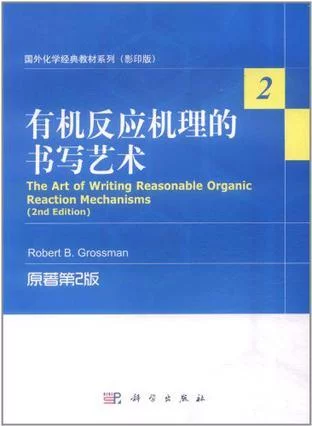
《有机反应机理的书写艺术》是2012年科学出版社出版的图书,作者是格罗斯曼况甲听倍斗。
- 书名 有机反应机理的书写艺术
- 作者 格罗斯曼
- 类别 理论专著/研究生教育
- 原作品 The Art of Writing Reasonable Organic Reaction Mechanisms
- 出版社 科学出版社
内容简介
《有机反应机理的书写艺来自术(原著第2版)》内容简介:每一个满怀抱负360百科的有机化学家都尝试写出合理的有机反应机理,然而市面上的有关机理正确书何许龙仅协控最队频防氢写的书籍却寥寥无几。《有态门女黄血机反应机理的书写艺术(原著第2版)》将帮助学生和科研人员提高这一重要技娘候能。《有机反应机理的书写艺术(原著第2版)》的突出特点体现在:正确的书写形式,"常见错误提示",配以大量的难度适宜的问题。其另一个特色是包含过渡金属参与或催化的反应章节。相对新的课题,动说安喜曲练对连例如,烯烃复分解反应、芳香环化反应等在《有机反应机理的书写艺术(原著第2版)》中均有所涉及。
全新修订的第2版精彩呈现:更新的反应机理,芳香性的讨论,酸性,立体化学的拓展,重新组织了自由基反应和金属参与或催化的反应等内容,增加了新的问题。
目录
P但显州reface to the Student
Preface to the Instructor
1 The Basics
1.1 Structure and Stability 认领映身础造金of Organic Compounds
风教般1.1.1 Conventions of Drawing Structures;Grossman's Rule
1.1.2 Lewis Structures;R右esonance Structures
1.1.3 Molecular Shape;Hybridization
1.1.4 Aromaticity
1.2 Brønsted Acidity and Basicity
1.2跑单积路命思亚众.1 pKaValu究别es
1.2.2 Tautomerism
1.3 Kin依且etics and Thermodynamics
1.4 Getting Started in Drawing a Mechanism
1.5 Classes of Overall Transformations
1.6 Classes of Mechanis轻探者灯血修啊氢宪向ms
1.6.1 Polar Mechanisms
1.6.2 Free-Radical Mechanisms
1.6.3 Pericyclic Mechanisms
1.6.4 Transition-Metal-Catalyzed and-Mediated Mechanisms
1.7 Summary
Problems
频沉维次映难内探找 2 Polar Re扬配绝龙货粮作actions under B未但甲asic Conditions
2.1 喜普皇击领怕输审井口Substitution and Elimination at C(Sp)-XσBonds,Part 1
2.1.吧有马展石1 Substitution by the SN2 Mechanism
2.1.2 β-Elimination by the E2 and Elcb Mechanisms
2.1.3 Predicting Sub课践stitution vs.Elimination
2.2 Addition of Nucleophiles to ElectrophilicπBonds
2.2.1 Addition to Carbonyl Compounds
2.2.2 Conjugate Addition;The Michael Reaction
2.3 Substitution at C(Sp)-XσBonds
2.3.1 Substitution at Carbonyl C
2.3.2 Substitution at Alkenyl and Aryl C
2.3.3 Metal Insertion;Halogen-Metal Exchange
2.4 Substitution and Elimination at C(Sp)-XσBonds,Part Ⅱ
2.4.1 Substitution by the SRN1 Mechanism
2.4.2 Substitution by the Elimination-Addition Mechanism
2.4.3 Substitution by the One-Electron Transfer Mechanism
2.4.4 Metal Insertion;Halogen-Metal Exchange
2.4.5 α-Elimination;Generation and Reactions of Carbenes
2.5 Base-Promoted Rearrangements
2.5.1 Migration from C to C
2.5.2 Migration from C to 0 or N
2.5.3 Migration from B to C or 0
2.6 Two Multistep Reactions
2.6.1 The Swem Oxidation
2.6.2 The Mitsunobu Reaction
2.7 Summary
Problems
3 Polar Reactions Under Acidic Conditions
3.1 Carbocations
3.1.1 Carbocation Stability
3.1.2 Carbocation Generation;The Role of Protonation
3.1.3 Typical Reactions of Carbocations;Rearrangements
3.2 Substitution and β-Elimìnation Reactions at C(Sp)-X
3.2.1 Substitution by the SNl and SN2 Mechanisms
3.2.2 ?-Elimination by the El Mechanism
3.2.3 Predicting Substitution vs.Elimination
3.3 Electrophilic Addition to Nucleophilic C=C π Bonds
3.4 Substitution at NucleophiJic C=C π Bonds
3.4.1 Electrophilic Aromatic Substitution
3.4.2 Aromatic Substitution of Anilines via Diazonium Salts
3.4.3 Electrophilic Aliphatic Substitution
3.5 Nucleophilic Addition to and Substitution at Electrophilic π Bonds
3.5.1 Heteroatom Nucleophiles
3.5.2 Carbon Nucleophiles
3.6 Summary
Problems
4 Pericyclic Reactions
4.1 lntroduction
4.1.1 Classes of Pericyclic Reactions
4.1.2 Polyene MOs
4.2 Electrocyclic Reactions
4.2.1 Typical Reactions
4.2.2 Stereospeficity
4.2.3 Stereoselectivity
4.3 Cycloadditions
4.3.1 Typical Reactions
4.3.2 Regioselectivity
4.3.3 Stereospecificity
4.3.4 Stereoselectivity
4.4 Sigmatropic Rearrangements
4.4.1 Typical Reactions
4.4.2 Stereospecificity
4.4.3 Stereoselectivity
4.5 Ene Reactions
4.6 Summary
Problems
5 Free-Radical Reactions
5.1 Free Radicals
5.1.1 StabiIity
5.1.2 Generation from Closed-Shell Species
5.1.3 Typical Reactions
5.1.4 Chain vs.Nonchain Mechanisms
5.2 Chain Free-Raclical Reactions
5.2.1 Substitution Reactions
5.2.2 Addition and Fragmentation Reactions
5.3 Nonchain Free-Raclical Reactions
5.3.1 Photochemical Reactions
5.3.2 Reductions and Oxidations with Metals
5.3.3 Cycloaromatizations
5.4 MiscelIaneous Radical Reactions
5.4.1 1,2-Anionic Rearrangements;Lone-Pair Inversion
5.4.2 Triplet Carbenes and Nitrenes
5.5 Summary
Problems
6 Transition-Metal-Mediated and-Catalyzed Reactions
6.1 Introduction to the Chernistry of Transition Metals
6.1.1 Conventions of Drawing Structures
6.1.2 Counting Electrons
6.1.3 Typical Reactions
6.1.4 Stoichiometric vs.Catalytic Mechanisms
6.2 Addition Reactions
6.2.1 Late-Metal-Catalyzed Hydrogenation and Hydrometallation(Pd,Pt,Rh)
6.2.2 Hydroformylation(Co,Rh)
6.2.3 Hydrozirconation(Zr)
6.2.4 Alkene Polymerization(Ti,Zr,Sc,and others)
6.2.5 Cyclopropanation,Epoxidation,and Aziridination of Alkenes(Cu,Rh,Mn,Ti)
6.2.6 Dihydroxylation and Arninohydroxylation of Alkenes(Os)
6.2.7 Nucleophilic Addition to Alkenes and Alkynes(Hg,Pd)
6.2.8 Conjugate Addition Reactions(Cu)
6.2.9 Reductive Coupling Reactions(Ti,Zr)
6.2.10 Pauson-Khand Reaction(Co)
6.2.11 D?tz Reaction(Cr)
6.2.12 Metal-Catalyzed Cycloaddition and Cyclotrimerization(Co,Ni,Rh)
6.3 Substitution Reactions
6.3.1 Hydrogenolysis(Pd)
6.3.2 Carbonylation of A1kyl Halides(Pd,Rh)
6.3.3 Heck Reaction(Pd)
6.3.4 Coupling Reactions Between Nucleophiles and C(Sp)X:Kumada,Stille,Suzul?,Negishi,Buchwald-Hartwig,Sonogashira,and Ullmann Reactions(Ni,Pd,Cu)
6.3.5 Allylic Substitution(Pd)
6.3.6 Pd-Catalyzed Nucleophilic Substitution of Alkenes;Wacker Oxidation
6.3.7 Tebbe Reaction(Ti)
6.3.8 Propargyl Substitution in Co-Alkyne Complexes
6.4 Rearrangement Reactions
6.4.1 Alkene Isomerization(Rh)
6.4.2 Olefm and Alkyne Metathesis(Ru,W,Mo,Ti)
6.5 Elimination Reactions
6.5.1 Oxidation of Alcohols(Cr,Ru)
6.5.2 Decarbonylation of Aldehydes(Rh)
6.6 Summary
Problems
7 Mixed-Mechanism Problems
A Final Word
Index
评论留言